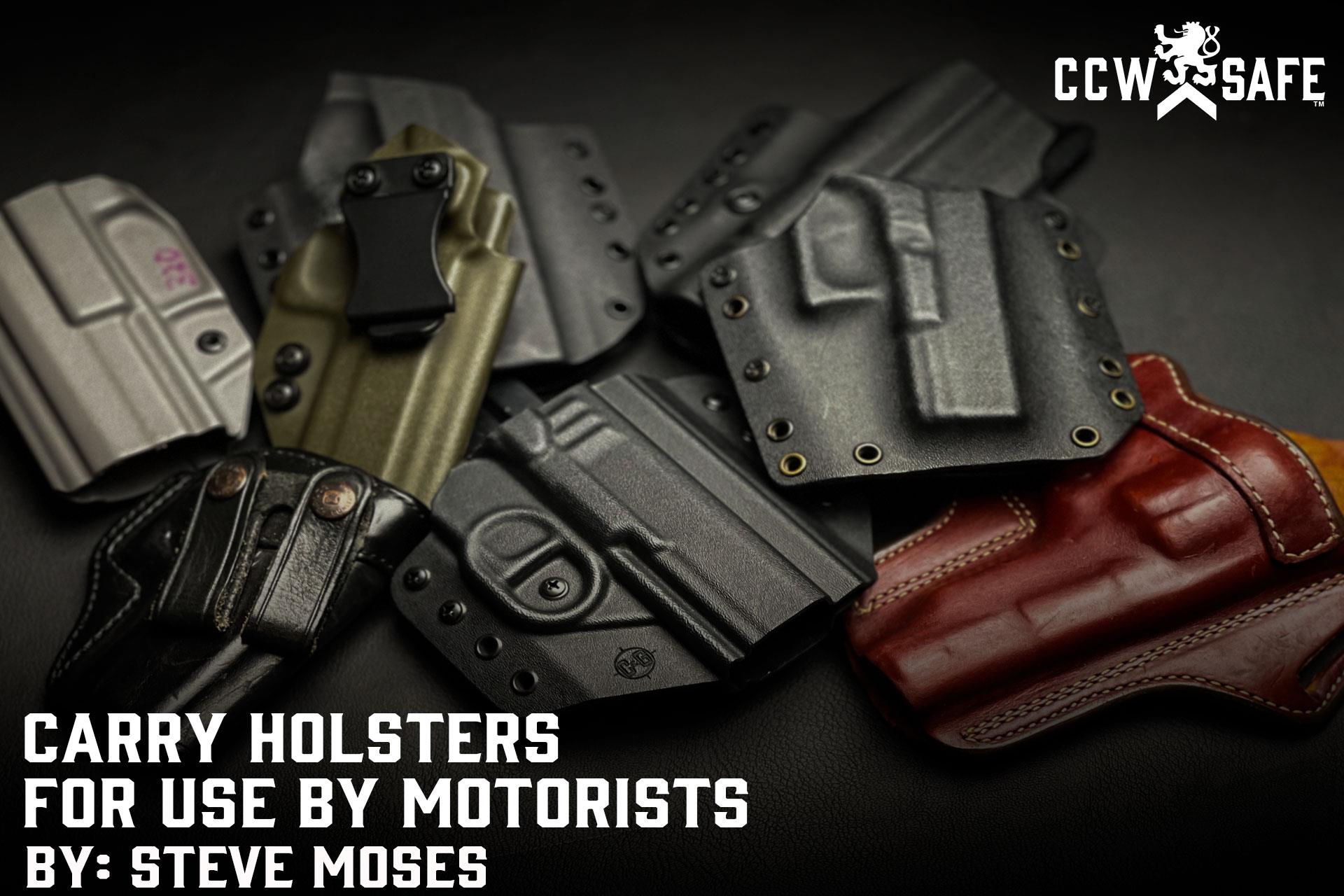
Posted on September 13, 2021
Carry Holsters For Use By Motorists
CCW Safe recently received a request from a member for an article about the best holsters for concealed carriers who might find themselves in a situation in which they are forced to draw and use their handguns while remaining seated in their vehicle. Rather than immediately describing what holsters that I prefer for carrying while driving (which are the same exact holsters I prefer for going about my day whether standing or seated) I am going to first focus on the reasons why I might need to draw my handgun while seated in my vehicle and address the challenges that I may face in safely getting my handgun into a position that I can effectively use it.
Is it advisable to secure my handgun off-body while driving? I would advise against this. If the handgun is not stored in a glove box, console, or even a purpose-built holster secured to a seat, console, or other rigid a location it may go flying in the event of an accident, while turning sharply at high speed, or coming to an abrupt stop. Precious time may be lost that cannot be made up if the concealed carrier suddenly needs to get his or her hands on a handgun that is carried off-body. Covertly accessing a concealed handgun is difficult anytime the driver has to extend their hands well away from the body. The number one reason that conventional holster carry makes sense is that the handgun is located in the same position when driving as it is when the concealed carrier is outside of the car. I will most likely default to my training under stress, and all of my training has revolved around carrying my handgun in a holster worn on my waistline.
Why would I need to draw my handgun while seated in my vehicle? I believe that I am in actual danger of being seriously injured or killed, I am unable to drive away, and I may have to shoot from inside of my vehicle in order to defend myself and possibly my passengers. If I can drive away from a developing situation, I will. If I cannot drive away at the moment but the threat of imminent serious bodily injury or death is not present, I might stay in my vehicle with the doors locked and windows closed. If my car is unable to move and I have concerns that if I remain in my vehicle that I might be seriously injured or killed, I might choose to leave the vehicle and move to a safer or more defensible area.
What are some of the challenges a concealed carrier might face if they need to actually draw their gun while remaining in the vehicle? Why am I unable to drive off? Am I parked with the engine off or am I accosted while stopped at a traffic light and unable to drive away? If the latter, I would prefer to put the transmission in Park, engage the emergency break, and slip my seat belt off. Once I have done this, I am in a better position to shift my position in the seat so that I can square my hips to the extent possible in the direction of the threat. Doing so can allow me to swivel and cover an area greater than 180 degrees. I slide my left hand across my torso and under my seat belt and then use it to unlatch the buckle. Doing so causes the seat belt when it retracts to completely clear my torso. That way if I must quickly get out of the vehicle my left arm is not snagged upon exiting. Naturally, I have to do the opposite when seated on the right side of the vehicle for the same reason.
What are some holster attributes that lend themselves to concealed carry while driving? My experience has been that the best type of holsters for seated carry are properly designed appendix holsters and close-fitting pancake holsters and inside-the-waistband hip holsters with a ten-degree cant and non-collapsible top. Proper drawing technique for holsters positioned on or near the hip may involve more elbow flare than usual. I find that I need to rock my torso slightly forward when drawing from the hip. Holsters with a neutral cant tend to be more difficult to draw from when seated in a car seat for me than the holster designs described above. I use a Keepers Concealment appendix holster for my Glock 48, JM Custom Kydex appendix holsters for my two revolvers, and a JM Custom Kydex Road Dog holster for hip carry on occasions when I need to wear a suit or sport coat.
What might I need to remember in regard to handgun safety? Not only do all four Firearm Safety Rules remain in place, but within a vehicle there exist far fewer safe directions to point a muzzle. My legs are directly in front of me, I may have a passenger seated right next to me, and I have no control over what lies on the other side of the windshields and windows. I need to refrain from crossing any part of my body when drawing or if I want to return my handgun to the holster.
What if I can’t carry a holster because of (blank) reason? CCW Safe has thousands of members, many of which are working around health issues, infirmities, and/or injuries. I have had lumbar fusion surgery twice myself, as well as two other surgeries that made conventional belt carry problematic at times. In the past I have relied on a purpose-built fanny pack holster for handguns as large as a Glock 19 as well as pocket holsters located in vest and jacket pockets for use with the Glock 43 and Smith & Wesson 442 .38 Special. Attributes of both were that they were located on my body, worked well seated and standing, and that I was not frequently switching back and forth between holsters depending upon what I was doing at the moment. Neither are as desirable as a concealed holster worn on the waistline, but sometimes we just have to make do.
Your mileage may vary. What has worked for me may not work for the next concealed carrier. My journey for knowledge is far from complete and over the years marked by a few dead ends and detours. Fortunately, I have been able to study under some excellent instructors and learn a few lessons the hard way, not only in classes, but out in the field. There are plenty of good holsters out there that will work as well as the ones that I mentioned above, but there is a reason I selected those particular holsters. I know that they can work well for me under a variety of circumstances as long as I do my part.
 |
Steve MosesSteve Moses has been a defensive firearms trainer for over 26 years and is a licensed Texas Personal Protection Officer with 7 years of experience performing as shift lead on a church security detail for a D/FW area metro-church. Steve is a co-owner and Director of Training for Palisade Training Group, LLC based in Dallas, Texas. Moses is a retired deputy constable and spent over 10 years on a multi-precinct Special Response Team. He owns multiple instructor certifications, including Rangemaster Advanced Handgun Instructor and Defensive Shotgun Instructor, Red Zone Knife Defense Instructor and Adaptive Striking Foundations Instructor, Modern Samurai Project Red Dot Sight Instructor, and State of Texas Personal Protection Officer Instructor. Steve holds a BJJ Brown Belt in Relson Gracie Jiu Jitsu. He is a content contributor for CCW Safe and writes weekly articles on various subjects of interest to concealed carriers. Moses shoots competitively and holds an IDPA Expert rating. Steve is an annual presenter at the Rangemaster Tactical Conference. |